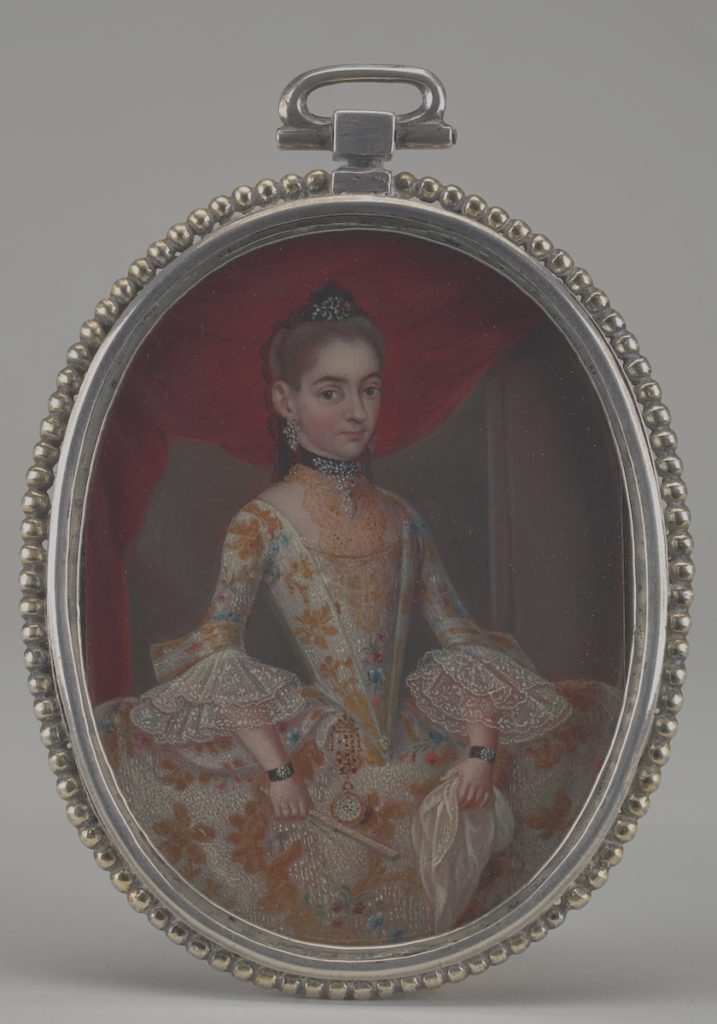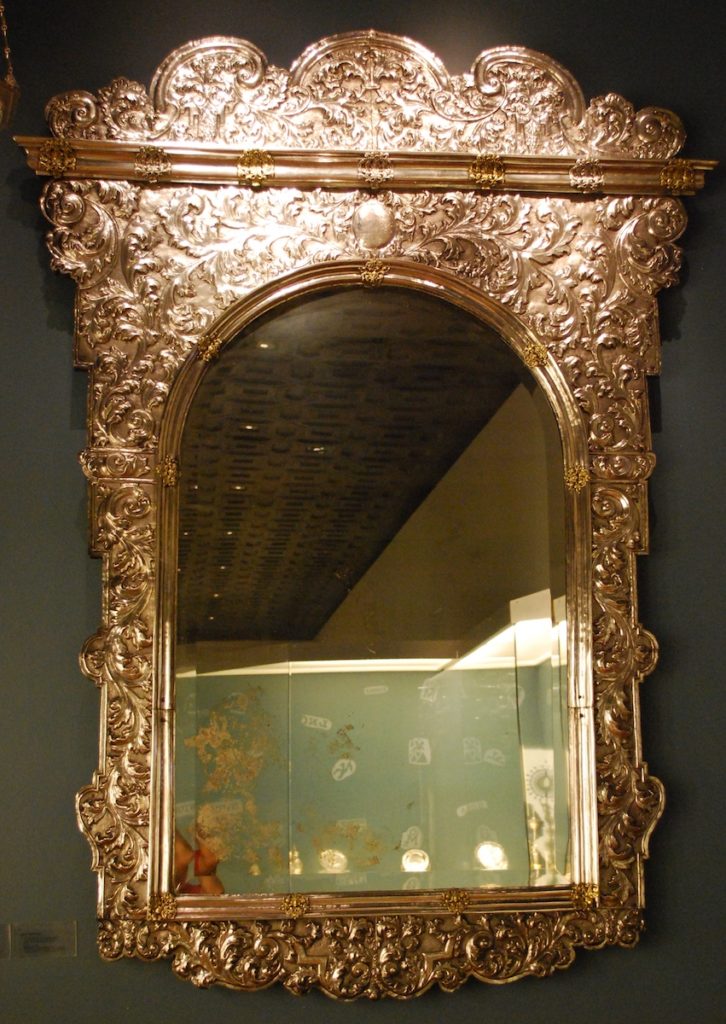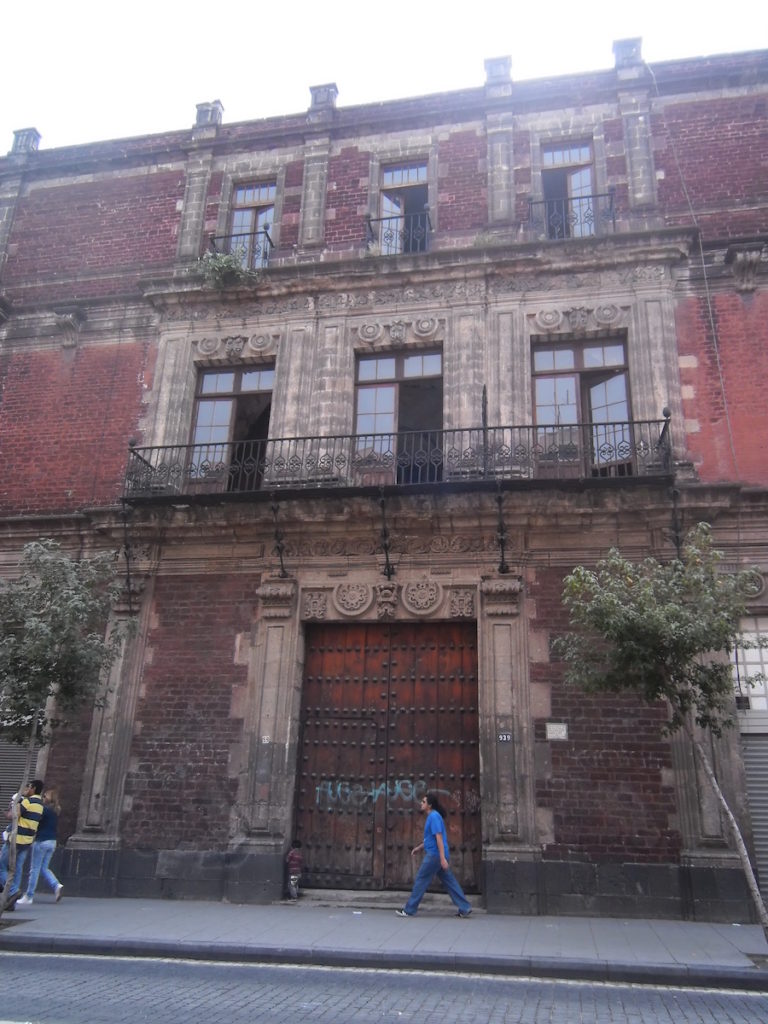James Middleton
The Denver Art Museum recently acquired an eighteenth-century Mexican portrait miniature painted on silver (Fig. 1). Datable to about 1770 by the sitter’s accessories and hairstyle, it represents a young woman wearing her era’s most formal garment, a court gown.[1] Why was she painted on such a luxurious material? Who was she? Why is an American wearing a European court gown? This essay seeks to answer those questions by placing the miniature in its historical context.

Silver-ground miniatures are rare. Due to the slightly translucent nature of oil paint, the use of this precious metal as a base imparts greater luminosity to the finished work than the more usual supports of copper, ivory, or cardboard.[2] In this case, the silver support is likely related to the silver bonanza that took place in eighteenth-century New Spain. Like the painting’s support, the sitter’s gown represents an example of the conspicuous consumption that characterized Mexico’s late eighteenth-century culture: the court gown was a very specific garment first ordained for wear at the court of Louis XIV, and appropriated by most of the courts of Europe in varying degrees of faithfulness to the French original.

Although the conquistadores had visions of limitless amounts of gold,[3] silver became the metal most identified with the New World and the most profitable for the Spanish.[4] American silver—found first in 1545 at Potosí (Bolivia) and subsequently near Zacatecas (Mexico)—quickly eclipsed other sources. By the 1750s, New Spanish silver production began to exceed that of South America.[5] Indeed, Mexico remains the world’s largest silver producer.[6] The late eighteenth century might well be called Mexico’s Silver Age, a time when New Spanish merchants and miners found themselves among the richest people in the Atlantic World. Luxurious silver objects swiftly became a staple of Spanish-American craftsmanship (Fig. 2). Colonial patrons who literally had more silver than they knew what to do with commissioned silver objects that would elsewhere have been made of wood, pottery, or lesser metals.
Mexico City, capital of the Viceroyalty of New Spain (of which today’s Mexico constitutes about a third), was an early-modern Dubai: a place of ostentatiously conspicuous consumption. By far the largest city in the Americas, its population was about 150,000 people in ca. 1770, equivalent to contemporary Venice or Amsterdam.[7] Late eighteenth-century Mexico City became a “City of Palaces” where newly rich miners and merchants built palaces in a highly ornate and strongly local style that was vastly different from the prim domestic architecture of British colonial America.[8]

The Mexico City palace of the silver magnate Pedro Romero de Terreros (of which the façade remains) boasted a stupendous number of silver objects (Fig. 3). Terreros had come from Spain in about 1730 to seek his fortune. He found it and—in an example of upward mobility impossible in Spain—was eventually ennobled as the Count of Regla. Don Pedro is credited with such extravagant gestures as temporarily paving the street between his house and the church with silver ingots for the christening of his first son.[9] In his residence, the principal salon contained “a richly carved silver frame for the portrait of [king] Carlos III… two chandeliers, also of silver, with seventeen arms each…seven large mirrors with silver frames.”[10] The Chapel featured “the lower part of the altar in silver, with applied ornaments of the same…four pilasters and their niche-head, all of silver… a frontal of silver… a silver chandelier of fifteen arms… holy vessels of chased silver, cruets, bells, candlesticks, lecterns, and suchlike…” [11] The Countess’s Dressing Room included:
A dressing-table with its drawers, tabletop, mirror, and frame with its escutcheon, all in wrought silver, and in the center of the escutcheon the Arms of the Lady Countess, the whole being three yards in height and one and-a-half wide…another large mirror of wrought silver… a chandelier equal to those of the salons…[12]
Still more silver embellished the Dining Room, including all of the usual tableware and a centerpiece of wrought silver weighing more than nine hundred marks valued at 11,736 pesos.[13]
Returning to the portrait, we cannot know who the subject was, but because she was painted on silver and wearing court dress, it seems likely the sitter was the wife or daughter of one of the silver magnates ennobled during the eighteenth century. [14] There is, however, an intriguing possibility that she was Terreros’ wife, María Antonia Trebuestos y Dávalos, since her known dates (1733-1766) fit neatly within the miniature’s presumed timeframe.
Clothing was the most important signifier of New Spain’s new wealth. In the immediate post-conquest era (1521-ca. 1572), the importation of luxurious European textiles became the first serious moneymaker for Mexican merchants.[15] The 1572 opening of the port of Manila, reached via Acapulco, marked the close of that era. Mexico City became the first market for Europe-bound Asian textiles that had previously been shipped around the horn of Africa. Asian silk, one of the principal objects of the Manila trade, sold in Spanish America for as little as one-ninth of its eventual price in Europe, affordable even for the poor, and an essential prop for American self-fashioning[16] This presented some interesting social dilemmas, as recounted in this excerpt from a 1778 chronicle:
Every tradesman goes forth on feast days with as much propriety and ostentation as a fleet-merchant, with two watches like the most eminent man… In this same way, their wives present themselves in clothing that is indistinguishable from that of the grandest ladies… so well dressed that one cannot tell which is the wife of a count, and which is that of a tailor.[17]
The chronicler’s difficulty in distinguishing a tailor’s wife from a countess reminds us that—unlike British America—New Spain had a titled nobility. Originally composed of the American-born criollo descendants of the conquistadores, after 1700 this group was dominated by self-made men, often Spanish-born peninsulares like Regla, who eagerly bought titles from a perennially cash-strapped Spanish Crown. These new people wed the impoverished descendants of the conquistadores, lived in opulence in Mexico City, and attended palace functions wearing elegant garments to show off their newfound status and taste.
We know little of New Spanish court culture because—officially—it did not exist. Viceroys were meant to remain aloof from their subjects, and because such socializing was technically forbidden, official sources are silent about court culture.[18] In practice, these rules were ignored, and a number of accounts and diaries can open a window on court life. The occasions that seem most likely to have induced women to wear court dress were the besamanos, or “hand-kissing” ceremonies held on the king’s birthday:
On the 23d (of September, 1753), the birthday of our catholic monarch, Don Fernando VI (may God preserve him), a mass of thanksgiving and a Te Deum were sung in the holy cathedral church [attended by] His Excellency and the Most Illustrious [Lord Archbishop], the [High Court], the tribunals and nobility… [T]he ceremony being concluded, all proceeded to the palace for a besamanos…[19]
This formal (and probably superlatively dull) ceremony in which courtiers processed, one at a time, across a large hall to kiss the viceroy’s hand seems a likely occasion for ladies to don their trajes de corte. Their long trains were an essential part of the ensemble and would have looked splendid in such a setting. For women of newfound wealth and status, clothing, at royal festivities and in portraits, served as an important expression of their integration into aristocratic society.
It is only within the last few years that a small number of New Spanish gowns—ten to be precise—have been identified as court costumes descended from the French grand habit. Eight of these appear in three paintings (only one painted on silver); two are extant garments. In Europe, the grand habit was meant to stand apart from fashion trends and to provide a sense of continuity and formality. In New Spain, where fashion was considerably less monolithic than in Europe, the court gown seems to have been an artifact of American self-fashioning.
In the 1670s, fashionable French women had begun to adopt a one-piece, shoulder-to-ankles overdress. Called a manto (mantua in English), this garment formed the basis of the eighteenth-century’s myriad front-closing robes (à la française, à l’anglaise, orà la polonaise) that today are collectively known as “round gowns” or “open robes.”[20] The front closure was deemed immoral because women could theoretically take them off without the assistance of a maid. In France, Louis XIV attempted to arrest this trend by decreeing that women appear at court in gowns based on those of the 1660s, consisting of three discrete pieces: a heavily boned, back-closing bodice, a skirt, and a separate train. This ensemble, known as the grand habit de cour, was adopted with variations by most of the courts of Europe. England produced a two-piece variant based on the manto, known as a court mantua, which had fitted sleeves and a train that was incorporated into the overdress. Spain united French and English practice, producing a garment that combined England’s fitted sleeves with France’s three-piece structure. The Mexican court gowns follow Spanish practice, with some local variation.

The details that distinguish the portrait subject’s dress from a standard-issue robe à la française are the bodice tabs which can be seen between her right cuff and the bodice point, indicating that bodice and skirt are indeed separate garments. The Denver silver miniature strongly resembles one of the best-known paintings in the colonial canon, Miguel Cabrera’s portrait of María de la Luz Padilla y Gomez de Cervantes (ca. 1752), whose gown displays the same bodice tabs as that in the silver miniature (Fig. 4).
There was indeed a court in New Spain, but it seems that there were no special regulations governing women’s court dress: if only ten New Spanish examples of gowns based on the grand habit exist, their use was probably not very widespread. My colleagues Martha Sandoval Villegas and Laura Vedrenne García have argued persuasively that several dresses in the collection of Mexico’s Museo Nacional de Historia, though not descended from the grand habit, are also court gowns.[21] Most of the known portraits of titled New Spanish Ladies feature fairly conventional European open robes. What seems to be going on here is that New Spaniards were choosing the grand habit as a (self-fashioning) fashion statement rather than submitting to it as a required garment. It also seems significant that no grand habit-adjacent gowns have yet been identified in Lima or the other viceregal capitals, making Mexico City’s penchant for court dress something of an anomaly in Spanish America.[22]
Returning, finally, to the Denver miniature, its inherent preciousness and the sitter’s extravagant gown should be seen in relation to New Spaniards’ standing and newfound wealth as suppliers of silver, and to a sense of their emerging status within the Atlantic world. Mexico’s eighteenth-century silver boom was largely responsible for the increased prosperity that would eventually result in the independence movements of the nineteenth century.[23]
James Middleton is an independent scholar working on dress in the Spanish-Colonial Americas circa 1520-1820
Acknowledgments: This essay is based on material excerpted from an online lecture I presented on February 3, 2022, as part of the Bard Graduate Center’s Brown Bag Lunch lecture series. The full lecture may be seen here: https://www.youtube.com/watch?v=UDNXguzM_rg (accessed October 24, 2022).
[1] I dealt with other aspects of this painting in my essay “A Prodigious Excess; Lace in New Spain and Peru, 1600-1800,” in Emma Cormack and Michele Majer, eds., Threads of Power: Lace from the Textilmuseum St. Gallen (New York: Bard Graduate Center; New Haven and London: Yale University Press, 2022), 155-175.
[2] Email conversation with gallerist Elie Shushan, June 9, 2022.
[3] Peter Bakewell, A History of Latin America to 1825 (Malden MA, USA: Wiley-Blackwell, 2010), 231.
[4] Bakewell, A History of Latin America to 1825, 225-226.
[5] Bakewell. A History of Latin America to 1825, 353-355.
[6] https://www.statista.com/statistics/253293/silver-production-volume-worldwide/ (accessed October 24, 2022).
[7] In 1790, New York had a population of 33,131. At 44,096, Philadelphia was roughly equal to the other largest Spanish American Cities, Puebla (Mexico) and Lima (Peru). Figures from Colin McEvedy, The Penguin Atlas of Modern History (London: Penguin, 1972), 65, and McEvedy, The Penguin Atlas of North American History, (London: Penguin, 1972), 54-59.
[8] This quote, traditionally ascribed to Alexander von Humboldt, comes fact from Charles Latrobe’s The Rambler in Mexico (New York: Harper & Brothers, 1836), 84.
[9] Couturier, 2003, 108.
[10] Manuel Romero de Terreros, “La Casa del Conde de Regla,” (Mexico City: Boletín de la Sociedad de Geografía y Estadistica de la República Mexicana, Quinta Época, 5 (1912) 426.
[11] Romero de Terreros, “La Casa del Conde de Regla,” 1912, 427.
[12] Romero de Terreros, “La Casa del Conde de Regla,” 1912, 427-428. At about 33 inches, the Spanish vara was roughly equivalent to an imperial yard.
[13] Romero de Terreros, “La Casa del Conde de Regla,”1912, 429, 431. 900 marks weighs approximately 450 pounds. The assessment of meaningful contemporary value to currencies of the past is an inexact practice. However, Luis Ortiz Macedo, speaking of the value of a 1784 inventory, suggests that “the unit should be multiplied by 100 thousand.” Luís Ortiz Macedo, Palacios nobiliarios de la Nueva España, (Mexico City: Universidad Nacional Autónoma de Mexico, 2009), 79, n. 54.
[14] Doris M. Ladd, The Mexican Nobility at Independence (Austin, TX: University of Texas Press, 1976),187-228.
[15] Peter Boyd-Bowman, “Spanish and European Textiles in Sixteenth-Century Mexico,” The Americas 29, no. 3 (January 1973), 334-358.
[16] William Lytle Schurz, The Manila Galleon (New York, Dutton, 1939), 32.
[17] Juan de Viera, “Breve compendiossa narración de la ciudad de México, corte y cabeza de la América septentrional,” La ciudad de México en el siglo xviii (1690-1780): tres crónicas (México: Consejo Nacional para la Cultura y las Artes, 1990), 256-257.
[18] Christopher Rosenmuller, Patrons, Partisans and Palace Intrigues (Calgary, Alberta: University of Calgary Press, 2008), 43.
[19] José Miguel de Casto Santa-Anna, Diario de sucesos notables (Mexico: Imprenta de Juan R. Navarro, 1854), 42.
[20] James Middleton, “Reading Dress in New Spanish Painting,” in New England, New Spain, Portraiture in the Colonial Americas, 1492-1850, ed. Donna Pierce (Denver, CO: Mayer Center for Pre-Columbian and Spanish Colonial Art at the Denver Art Museum, 2016), 101-146.
[21] Laura García Vedrenne, “El Reconocimiento Tecnológico Tecnológico y Material Como Fundamento para la Conservación de un Vestido de Alta Corte del Siglo XVIII…” Master’s thesis, Guadalajara, MX: Escuela de Conservacióm y Restauración del Occidente, 2016, 12-19.
[22] An infamous caricature-portrait of the colonial governor of New York, Lord Cornbury shows him cross-dressed as his cousin Queen Anne in an English court Mantua: https://en.wikipedia.org/wiki/Edward_Hyde,_3rd_Earl_of_Clarendon (accessed October 28, 2022).
[23] Ladd, The Mexican Nobility at Independence, 3-12.
Cite this article as: James Middleton, “An Eighteenth-Century Portrait Miniature on Silver: An Artifact from the Silver Age of Mexico,” Journal18, Issue 14 Silver (Fall 2022), https://www.journal18.org/6568.
Licence: CC BY-NC
Journal18 is published under a Creative Commons CC BY-NC International 4.0 license. Use of any content published in Journal18 must be for non-commercial purposes and appropriate credit must be given to the author of the content. Details for appropriate citation appear above.
